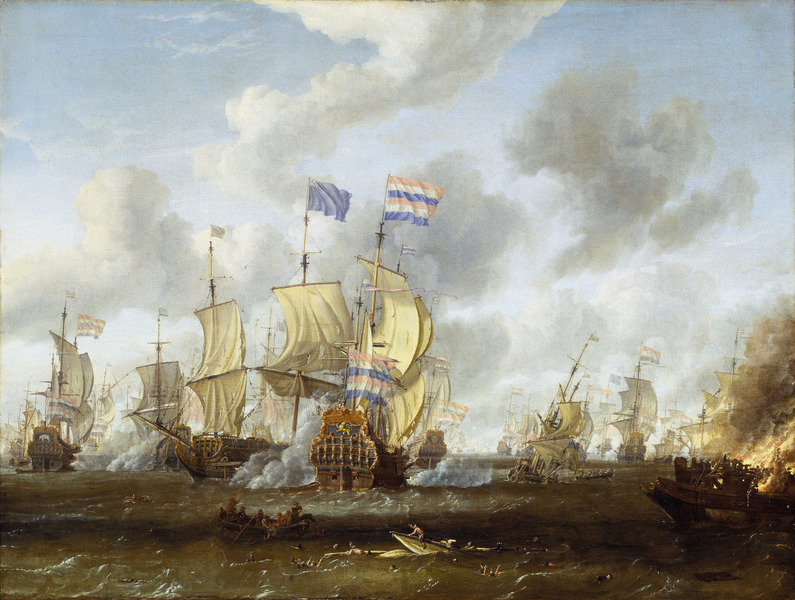Image: The Goulden Leeuw Engaging Royal Prince at the Battle of the Texel, 11 August 1673 RMG BHC0307f

Description: The Goulden Leeuw Engaging Royal Prince at the Battle of the Texel, 11 August 1673 The Battle of the Texel was the last fleet action of the Third Dutch War, 1672-74, between the Dutch on one side and the English and French on the other. It represented the final attempt by the allies to destroy the Dutch fleet and so leave their coast free for invasion. Although the allies were superior in numbers they were not sufficiently united and this weakness was exploited by the Dutch commander, Lieutenant-Admiral Michel de Ruyter. At Texel, he therefore concentrated on the English squadrons in slightly superior numbers and after a hard day's fighting the action ended with no major unit taken or destroyed on either side. The painting shows the action at an early stage and is principally concerned with the duel between Sir Edward Spragge, the Admiral of the allied rear squadron, and the commander of the Dutch rear squadron, Lieutenant-Admiral Cornelis Tromp. During this, both Spragge and Tromp moved their flags from one ship to another, and during a second shift of his flag Spragge's boat was hit and sank, drowning the admiral. Tromp's flagship, the 'Goulden Leeuw', 80 guns, is shown nearly stern-on in the centre of the canvas, flying Tromp's double-prince flag at the main. She is on the port tack and masks the stern of the 'Royal Prince', 100 guns, whose port bow protrudes through the gun-smoke. It is early in the action as the 'Royal Prince's' mizzen mast is still standing, with Spragge's blue flag as an admiral of the van squadron shown flying. On the extreme left, the 'Olifant', 82 guns, is shown stern-on in action, identifiable by a carved elephant on the stern. The 'Hollandia', 86 guns, in port-quarter view, is partly visible beyond the 'Goulden Leeuw'. In the right foreground, a fireship burns itself out and in the middle distance another small English fireship, is sinking. The retreating form of the 'Zeven Provincien', 80 guns and a glimpse of the 'Royal Sovereign', 100 guns, can be seen in the background to the right. In the foreground, the artist has concentrated on the human cost of the action. He shows several small boats moving through the water attempting to rescue men and pull them out of the water. One figure is sitting on the topmast of a ship that has already sunk and another hangs onto the rigging. Other figures in the water are shown in various positions, highlighting the desperation of their plight. The artist trained and worked with his father and became a member of the Guild of St Luke in Amsterdam. His river and coastal scenes were influenced by Ludolf Backhuysen, Willem van de Velde the younger and Jan Abrahamsz Beerstraten. He showed considerable accuracy in depicting ships' rigging and technical details, and his Dutch harbour and river views often depict the recreational and ceremonial aspects of shipping. In particular, he concentrated on showing pleasure yachts and ceremonial gatherings of ships. He also concentrated on depictions of both spectators and passengers. In such work, he showed great skill depicting the human figure, through characterization and attention to costume and detail. The Golden Leeuw Engaging The Royal Prince at the Battle of the Texel, 11 August 1673'
Title: The Goulden Leeuw Engaging Royal Prince at the Battle of the Texel, 11 August 1673 title QS:P1476,en:"The Goulden Leeuw Engaging Royal Prince at the Battle of the Texel, 11 August 1673 " label QS:Len,"The Goulden Leeuw Engaging Royal Prince at the Battle of the Texel, 11 August 1673 " label QS:Lnl,"'De Gouden Leeuw' bestookt 'The Royal Prince' in de zeeslag bij Texel, 11 augustus 1673"
Credit: http://collections.rmg.co.uk/collections/objects/11799
Author: Abraham Storck
Permission: The original artefact or artwork has been assessed as public domain by age, and faithful reproductions of the two dimensional work are also public domain. No permission is required for reuse for any purpose. The text of this image record has been derived from the Royal Museums Greenwich catalogue and image metadata. Individual data and facts such as date, author and title are not copyrightable, but reuse of longer descriptive text from the catalogue may not be considered fair use. Reuse of the text must be attributed to the "National Maritime Museum, Greenwich, London" and a Creative Commons CC-BY-NC-SA-3.0 license may apply if not rewritten. Refer to Royal Museums Greenwich copyright.
Usage Terms: Public domain
License: Public domain
Attribution Required?: No
Image usage
The following 2 pages link to this image:

